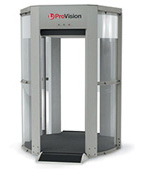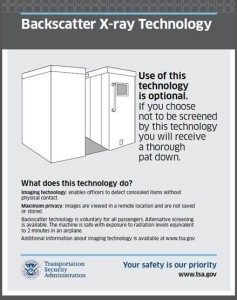There are a variety of foods, drinks, products, and even situations that medical professionals recommend pregnant women limit or avoid altogether. This guide provides an overview of air travel while pregnant and airline policies on the topic, but it is no substitution for seeking and following the advice of your medical professional, so consult her or him.
RELATED:
Top Travel Gear
My Travel Deals
GUIDE: 11 Traveling Tips For Seniors
GUIDE: 9 Tips When Traveling With An Alzheimer’s Dementia Companion
GUIDE: Are You Allowed To Smoke E-Cigarettes On A Plane?
AT TSA SECURITY
Before you even step onboard the plane, concerns often start with the safety and risks involved with passing through a TSA checkpoint. Passengers encounter the traditional “walk-through” metal detectors or one of two types of Advanced Imaging Technology (AIT) machines:
Metal Detector -The “traditional” metal detectors operate through the use of magnetic fields that emit non-ionizing radiation that does not cause biological damage, thus is not a risk to us, even with repeat exposure.
Millimeter Wave AIT Machines – These AIT scanners use non-ionizing radio frequency energy in the millimeter wave spectrum to generate a three-dimensional image of the body based on the energy reflected from the body. The image, which resembles a fuzzy photo negative with facial features blurred for privacy, is displayed on a remote monitor for analysis to determine whether potential threats are present. The energy projected by millimeter wave technology is thousands of times less than a cell phone transmission, according to the TSA.
Backscatter AIT Machines – These advanced imaging machines (the ones you stand in with your arms up) use energy being emitted in the form of ionizing radiation that has repeatedly been deemed negligible. For example, compare the radiation exposer from being on a flight from New York to Los Angeles (~4 millirem) as about 800 times that of one backscatter screening (~0.005 millirem), according to the TSA here. Put another way, research showed that the small amount of radiation received during one full-body scan, lasting approximately 8 seconds, is equal to the amount of radiation received in 2 minutes of a flight. (In depth: “Assessing cancer risks of low-dose radiation“; “Airport Full-Body Screening: What Is the Risk?“)
Additionally, TSA states it regulates and routinely tests each individual machine that uses X-ray technology to ensure the radiation emitted falls within the national safety standards. The testing is conducted by manufacturers and/or third party maintenance providers, per the terms of their TSA contracts. Contract requirements mandate that the manufacturer notify TSA and the Food and Drug Administration (FDA) should any equipment appear to emit radiation at levels above the national standard. In the event that a radiation test for any technology were to reveal that the emission was above the standard, the machine would be taken out of service and repaired. Lastly, the TSA states that backscatter technology in use at airports is designed to be physically incapable of producing the amount of energy needed to emit radiation above the national standard in a single scan. (In depth: search for “ANSI/HPS N43.17” which is a consensus radiation safety standard.)
Opting Out – All flyers passing through TSA security checkpoints have the option to “opt out” of passing through a screening machine and requesting a physical pat-down. As an expecting mother, your pat-down would be conducted only by a female screener, who should advise you about the process. As you approach the TSA screening area, simply tell the nearest TSA Security Officer, “I [am pregnant and] would like to opt out.” Then, follow their directions. Additionally, if you prefer a private screened area and/or a seat for the pat-down to take place, it should be provided for you. See more here directly from the TSA on pat-downs.
BONUS: For related information on getting TSA PreCheck qualification, see 7 Reasons To Get Global Entry (Instead of TSA PreCheck)!
FLYING
What kind of risks may be involved with flying while pregnant?
Several airline policies are below, but women still should confirm with the airline to find out their specific requirements for expecting mothers. According to the CDC, “the lower oxygen tension should not cause fetal problems in a normal pregnancy, but women with preexisting cardiovascular problems, sickle cell disease, or severe anemia (hemoglobin <80 g/L) may experience the effects of low arterial oxygen saturation.”
As hinted to above, while there is increased exposure to cosmic radiation during air travel, you may find far greater health risks from potential exposure to communicable diseases or deep vein thrombosis (see TIPS below). As all travelers should do, practice healthy habits while on the ground and in the air, such as washing your hands often, walking around when you can, and drinking plenty of water.
For relieving the symptoms of morning sickness and motion sickness, you might want to bring some nonprescription remedies along such as pyridoxine (vitamin B6) and ginger products (e.g. Preggie Pop Drops).
AIRLINE POLICIES
Here is a list of various airline policies of pregnant passengers:
American Airlines: Policy is here.
A medical certificate is required if you will be traveling within four weeks of your delivery date in a normal, uncomplicated pregnancy. Additionally, domestic travel is not permitted when requested within seven days before or after the delivery date without a medical certificate and clearance by a Special Assistance Coordinator (SAC). International travel is not advised within 30 days of the due date, unless the passenger is examined by an obstetrician within 48 hours of the outbound departure and certified in writing as medically stable for flight. Travel within ten days of the due date on international travel must have SAC clearance. Travel within seven days after delivery requires SAC clearance. For more information, please contact a Special Assistance Coordinator through AA Reservations at 800-433-7300.
Delta Air Lines: Policy is here.
Delta does not impose restrictions on flying for pregnant women, so a medical certificate is not required to travel. Keep in mind, however, that ticket change fees and penalties cannot be waived for pregnancy. If you’re traveling after your eight month, it’s a good idea to check with your doctor to be sure travel is not restricted.
Hawaiian Airlines: Policy is here.
Hawaiian Airlines will not transport a passenger expecting delivery within 7 days, with the exception being passengers with a Doctor’s certificate provided dated within 72 hours of departure stating passenger has been examined and found to be physically fit for transportation and will not require any extraordinary medical attention during the flight. If, however, on the day of departure, Hawaiian Airlines feels that the passenger does not seem fit to fly, the decision to accept the passenger will be made only after medical personnel are contacted, the passenger is examined and cleared to take the flight.
JetBlue Airways: Policy is here.
Pregnant Passengers expecting to deliver within seven days are prohibited from travel, unless such Passenger provides a doctor’s certificate dated no more than seventy-two (72) hours prior to departure stating that the Doctor has examined and found the Passenger to be physically fit for air travel to and from the destinations requested on the date of the flight and that the estimated date of delivery is after the date of the last flight.
Southwest Airlines: Police is here.
While air travel does not usually cause problems during pregnancy unless delivery is expected within 14 days or less, in some cases, traveling by air has been known to cause complications or premature labor. Female Customers at any stage of pregnancy should consult with their physicians prior to air travel. Southwest Airlines recommends against air travel beginning at the 38th week of pregnancy. Depending on their physical condition, strength, and agility, pregnant women may, in some cases, be asked not to sit in the emergency exit row.
Spirit Airlines: Policy is here.
Customers who are pregnant are urged to consult with their physician on whether it is safe to travel by air, including with due consideration to the possibility of turbulence, cabin pressurization, significantly increased risk of deep vein thrombosis associated with pregnancy, and lack of ready access to medical care. This is particularly important for women in their ninth month of pregnancy, who are urged to obtain an examination from her physician shortly before flying to confirm that flying by air will be safe. Women with a history of complications or premature delivery should not fly at all. By travelling with Spirit, pregnant women acknowledge and accept these risks.
United Airlines: Policy is here.
Any woman in the first eight months of pregnancy will be allowed to travel on a United flight without medical documentation. A woman traveling during her ninth month of pregnancy must have the original and two copies of an obstetrician’s certificate, which must be dated within three days (72 hours) prior to her flight departure. To best assure the pregnant traveler’s safety, it is preferable to have a certificate dated within one day of flight departure. The certificate must state that the obstetrician has examined the customer and found her to be physically fit for air travel between the specified dates. The estimated birth date of the baby must be after the date of the last flight on the itinerary. The customer should provide the original certificate to a United Representative at check-in. The remaining copies are for reference during air travel.
Virgin America/Atlantic: Policy is here.
Multiple considerations for single or multiple pregnancies and an information form to complete.
TIPS
– Consult: Talk with your medical professional about any air travel plans.
– Extra Time: Allow more time to get through security (especially when opting out) and to maneuver the airport.
– Extra Space: Inquire both at the ticketing counter and the gate if there is any upgrade options, extra legroom options, or even getting you to an aisle seat. Also consider opting for the front row to nix the possibility of a reclining seat heading back to your belly.
– Help: Ask for it! From staff to your friendly neighbor, don’t be modest, there is help at every turn at the airport.
– Plan: Hope for the best, plan for the worst. Research the medical facilities and their locations for where you are traveling. Have doctor contact information and health insurance cards at the ready and, if you’re traveling with others, keep them informed too.
– Medications: Keep medications, OTC drugs and vitamins in their original containers. The 3-1-1 Rule still applies too.
– Clot Risks: Consult with your medical professional about taking a baby aspirin while traveling, using compression socks, or other recommendations.
– Walk Around: Walk around in the aisle about every half hour to promote circulation too. If you’re hydrating properly, you’ll probably be getting up that often anyway!
READ
More info from the CDC: Advising Travelers With Specific Needs-Pregnant Travelers
WATCH
TSA Tips for Pregnant Travelers
____
@travelblawg
facebook.com/travelblawg
Subscribe in the sidebar!
Disclosure of Material Connection: Some of the links in the post above are “affiliate links.” This means if you click on the link and purchase the item, I will receive an affiliate commission.








nice guidance for air travel pregnant. thank you
[…] Guide: Air Travel While Pregnant: Mark over at TravelBlawg just made some big news public – he’s going to be a dad of twins! So it goes without saying that he and his wife have been learning their stuff about travel during pregnancy. Yesterday, he put together a very comprehensive post detailing all the concerns and issues that might arise for pregnant travelers. All I can say is that this is my kind of post, particularly the part where he lays out the rules of pregnancy and travel for every airline. We lawyers clearly think alike! Welcome, Mark, to the family travel blogosphere!… Read more »